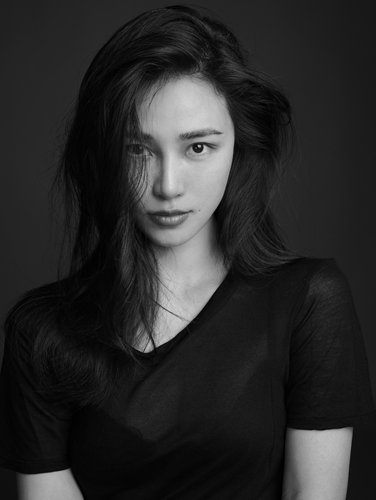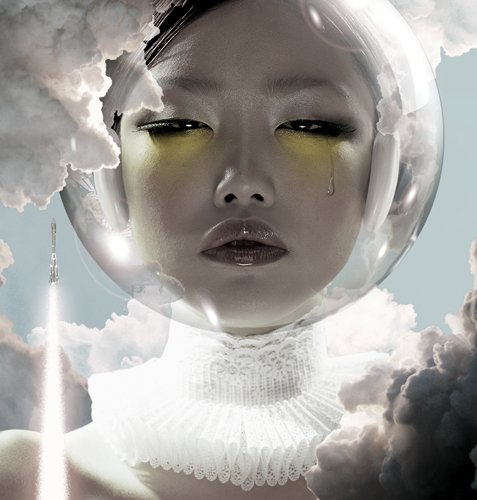HOME >> ARTS
Chen Man, China’s shinning star in photography
By Chen Xi Source:Global Times Published: 2019/9/4 18:36:20

Chinese photographer Chen Man Photo: Courtesy of Studio-6

Astronaut by Chen Man Photo: Courtesy of Studio-6
Under the red light of a fire, a woman with long hair holding a sharp sward looks straight on with penetrating expression, ready to take to battle. The photo is the work of Chen Man, China's answer to US portrait photographer Annie Leibovitz, for the upcoming Disney film Mulan and shows off the courageous character of the heroin Hua Mulan.
Born in a small home located in a Beijing hutong (a traditional alleyway) in 1980, Chen started to learn how to paint when she was 3 years old. This hard working girl liked to observe people in the hutong and uncover the characteristics that made them who they were when she drew her portraits, which laid a good foundation for her to switch over to photography in later years.
"I chose to major in photography when I went to college because I wanted to talk to people instead of sitting in a painting studio out of contact with everyone," Chen told the Global Times.
Unique perspective
Chen started to emerge in the fashion field while she worked at Vision, a Chinese fashion magazine, in 2003. Her artworks were admired in fashion circles for their refreshing ability to shock viewers with how she was always able to capture the pure nature of each subject.
"I do not talk when shooting... Observation is very important because what you see is what you get. Many celebrities are labeled by society, but I need to remove those labels and see what the essence of the person is. In fact, everyone's moments are different. You have to observe the reactions of people and expand the characteristics that he or she needs to optimize at that moment. Many master-level photography works capture a single moment," she said, and noted that many news photographers do not communicate with the people they take pictures of and they do not know each other, but the photos they take are very harmonious and reveal unique angles.
Many of these moments can be seen in the cover spread for the August issue of Harper's Bazaar China, which featured Barbadian pop sensation Rihanna dressed in full Chinese regalia.
Chen's photos were a huge hit on social media, with the hashtag for the shoot getting 150 million views on Sina Weibo. The photos capturing the singer's regal beauty also earned hundreds of thousands of likes on Twitter.
After cooperating with many top-of-the-line celebrities, Chen joked that she started to feel like an elderly lady as she witnessed numerous Chinese celebrities grow up before her lens. She said one of the most impressive subjects she photographed was Stan Lee, the well-known US comic book writer, editor, publisher and producer.
"On the way to Stan Lee's office, I thought he would work on the top floor of a special modern building. But when we arrived, I found he was in a small and inconspicuous office with a lot of pictures hung on the wall. These included group photos with the Beatles, Michael Jackson and US presidents, but most of them were photos of him and his wife. I then heard that he continued to work just three months after his wife passed away. Although he was more than 90 years old, he spoke very clearly and his mind was still very agile. I used to think that artists could only find inspiration when they have difficult experience in life, but at that moment I realized that an artist who creates true mainstream values and is influential in the world can also live a very simple life and that they are very focused and full of creative ideas," said Chen.
Phases of growth
Chen noted that her 15-year photography career can be divided into three periods.
"I call my first stage 'polish' because I was so focused on expressing and proving myself that I kept polishing my photography works again and again. My second stage is 'no polishing,' which was to take things away. In this stage, I wanted to explain myself without too many ornaments. The third stage is 'it is okay to be polished or not,' which means just focusing on showing my central idea. Photography is what you want to be with a person, an object, a scene, a moment, always together or never, and at the same time, it is a glimpse of an inner moment that cannot be perceived," she said.
Vogue, Harper's Bazaar, Elle, i-D and other major magazines sit on Chinese wooden shelves taking up a large amount of space in Chen's Studio-6.
"'Relaxed,' 'focused,' these two words can exactly describe Chen's style. She often changes her original ideas and comes up with a new and fresh one at the very moment she presses a button to take a photo with her camera," Hu Yuchen, the studio's international producer, told the Global Times.
"Many people ask me how I am able to maintain quality and efficiency throughout so many shoots and subjects. You know, sometimes, I have to shoot four covers for magazines each day. I think people often let time go by during their leisure time. When people calm down, they must be with themselves, encounter unconventional life experiences and enrich themselves, if they do then they will certainly find inspiration," she said.
"There are many types of photography. I just belong to one of them. I will keep learning, and I hope the entire field in China can accompany me during this process together so that more and more Chinese photographers can stand on the international stage," Chen said.
Newspaper headline: Capturing the moment
Posted in: PHOTOGRAPHY